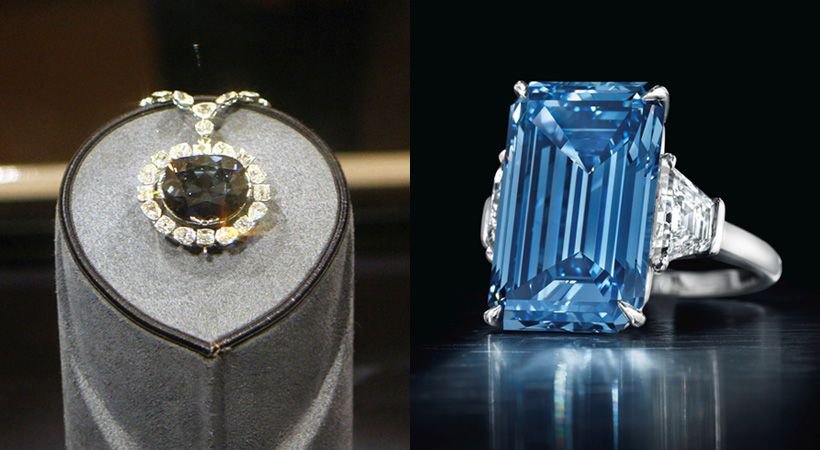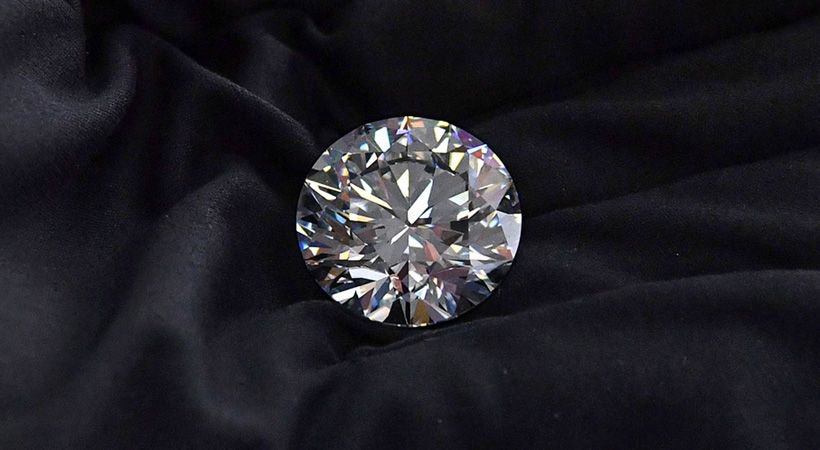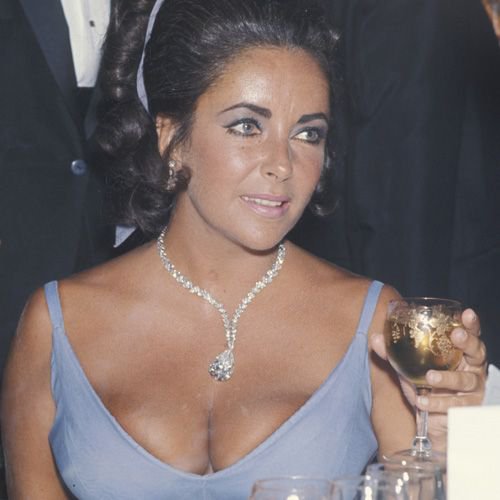Stay abreast of COVID-19 information and developments here
Provided by the South African National Department of Health
The diamonds that
(really) cut it
Their exotic names and mystique are the stuff of swashbuckling tales and staggering sums of money. But just how popular are name diamonds as investment tools, and how prevalent are they?
Diamonds are but lumps of carbon, the critics scoff – but give a stone a name and everything changes.
On occasion, a jewel so extraordinary is discovered that it marks its place in history forever. Take the Hope diamond: it traversed four centuries, passing through the hands of adventurers, scoundrels, thieves … and the occasional king or two.
Although exceedingly rare, such stones still appear sporadically. A recent example is the Oppenheimer Blue that famously sold for a record US$57 million last year. As is fitting for a legendary diamond, its back-story is as colourful as its multiple facets.
So goes the story: Jonathan Oppenheimer, son of Nicky, acquired it after hearing rumours of a spectacular stone unearthed deep in a jungle in the heart of the Democratic Republic of Congo. Oppenheimer chartered a plane and tracked down the villager, verified the diamond’s worth and made an offer.
A bargain was struck for several million dollars. The villager, having no bank account, demanded payment in cash.

Left to right: the Hope and Oppenheimer Blue diamonds.
Young Oppenheimer complied – he returned a month later, in a bigger plane, reportedly with bodyguards and bin bags holding millions of dollars in cash, plus travel documents for the villager and his family. The clan was relocated to London along with its millions – and Oppenheimer secured the stone.
After years of cutting and polishing, it was eventually revealed to the public in its new form and finally put up for auction.
Name diamonds such as the Oppenheimer Blue do not come around very often though …
‘Only the highest-quality, rarest, most desired diamonds become name diamonds,’ says Paul Zimnisky, an independent New York-based diamond analyst and consultant. ‘It’s the blues, the pinks, the reds and larger flawless whites.’
Also, it really is a case of size does matter. These are large stones, the smallest being the size of a duck egg. The majority of mined diamonds are mere fragments, so anything that is fist-sized is a find to remember.
Given the number of zeros on the end of the price tag for one of these rare jewels, the potential list of customers is short.
‘With the price point of these diamonds starting in the high-tens and hundreds-of-thousands of dollars, the investor base is limited,’ Zimnisky says.

The 51.38-carat round-cut diamond – the Dynasty diamond – forms part of the Dynasty collection, owned by Russian diamond miner Alrosa. Manufactured from a 179-carat Romanovs rough diamond and extracted at the company’s Nyurbinskaya kimberlite pipe in Russia’s far northeast region of Yakutia in 2015, the company plans to sell the entire collection at an online auction in November.
It is these quality stones that draw investors. Not only are they rare, the likelihood of more being found dwindles even further as the source of such gems runs out.
Most of the world’s diamonds were formed deep in the earth millions of years ago – up to 300km down, in some instances. They are usually brought to the surface by volcanic activity – in pipes of lava. These pipes harden and become the diamond-bearing kimberlites sought by miners.
Kimberlites are themselves a geological rarity, with the last major discovery made nearly three decades ago. So scarce are these deposits that they attract a special kind of investor – one with very deep pockets and a love of shiny things.
A couple of years ago, a mysterious company called Triangle General Trading, based in Dubai, shook hands on a deal with London mining firm Paragon Diamonds. Paragon has the rights to mine Lesotho kimberlites, from where it expects to find at least one name diamond a year. The investors, meanwhile, consist of a group of connected Middle Eastern royalty.

The iconic late actress Elizabeth Taylor wears the Taylor-Burton diamond on a necklace at the 1970 Oscars’ Ball at the Beverly Hilton Hotel. The 9.42-carat stone was one of many of Richard Burton’s extravagant gifts to his wife during their tumultuous marriages.
‘These investors are connected to the royal families of the UAE and Saudi Arabia,’ says Hugo Philion, a member of the management team at Paragon. ‘Through them, we will be talking to some very interesting people who want to acquire our sizeable supply of large investment-grade diamonds direct from the mine, and who are intent on making Dubai the number one diamond centre in the world.’
What this illustrates, however, is how difficult it is for the ‘ordinary’ investor to access investment-grade diamonds. Most experts agree that store-bought diamonds are little more than pretty baubles that retain their value about as well as a used Volkswagen diesel.
An exception possibly is the diamond certicard sold by some jewellers. This is a tamper-proof card containing embedded diamonds that can be bought and traded on the value of the stones it contains. A certicard can cost as little as US$100 to tens of thousands, depending on its content. Investment-grade name diamonds, meanwhile, will continue to appeal to the very rich. They are portable and, when on display, have the priceless advantage of bragging rights.
‘We see a shift into diamonds both as an asset class and a store of value as a currency surrogate, especially for the ultra-wealthy, as both geopolitics and the global monetary system becomes more unstable with persistent quantitative easing,’ says Philion.
It’s a case, however, of naming your price.
When formulating your investment strategy, we focus on your specific needs, life stage and risk appetite.
Greg Stothart has spent 16 years in Investment Management.

Have a question for Greg?
South Africa
South Africa Home Sanlam Investments Sanlam Private Wealth Glacier by Sanlam Sanlam BlueStarRest of Africa
Sanlam Namibia Sanlam Mozambique Sanlam Tanzania Sanlam Uganda Sanlam Swaziland Sanlam Kenya Sanlam Zambia Sanlam Private Wealth MauritiusGlobal
Global Investment SolutionsCopyright 2019 | All Rights Reserved by Sanlam Private Wealth | Terms of Use | Privacy Policy | Financial Advisory and Intermediary Services Act (FAIS) | Principles and Practices of Financial Management (PPFM). | Promotion of Access to Information Act (PAIA) | Conflicts of Interest Policy | Privacy Statement
Sanlam Private Wealth (Pty) Ltd, registration number 2000/023234/07, is a licensed Financial Services Provider (FSP 37473), a registered Credit Provider (NCRCP1867) and a member of the Johannesburg Stock Exchange (‘SPW’).
MANDATORY DISCLOSURE
All reasonable steps have been taken to ensure that the information on this website is accurate. The information does not constitute financial advice as contemplated in terms of FAIS. Professional financial advice should always be sought before making an investment decision.
INVESTMENT PORTFOLIOS
Participation in Sanlam Private Wealth Portfolios is a medium to long-term investment. The value of portfolios is subject to fluctuation and past performance is not a guide to future performance. Calculations are based on a lump sum investment with gross income reinvested on the ex-dividend date. The net of fee calculation assumes a 1.15% annual management charge and total trading costs of 1% (both inclusive of VAT) on the actual portfolio turnover. Actual investment performance will differ based on the fees applicable, the actual investment date and the date of reinvestment of income. A schedule of fees and maximum commissions is available upon request.
COLLECTIVE INVESTMENT SCHEMES
The Sanlam Group is a full member of the Association for Savings and Investment SA. Collective investment schemes are generally medium to long-term investments. Past performance is not a guide to future performance, and the value of investments / units / unit trusts may go down as well as up. A schedule of fees and charges and maximum commissions is available on request from the manager, Sanlam Collective Investments (RF) Pty Ltd, a registered and approved manager in collective investment schemes in securities (‘Manager’).
Collective investments are traded at ruling prices and can engage in borrowing and scrip lending. The manager does not provide any guarantee either with respect to the capital or the return of a portfolio. Collective investments are calculated on a net asset value basis, which is the total market value of all assets in a portfolio including any income accruals and less any deductible expenses such as audit fees, brokerage and service fees. Actual investment performance of a portfolio and an investor will differ depending on the initial fees applicable, the actual investment date, date of reinvestment of income and dividend withholding tax. Forward pricing is used.
The performance of portfolios depend on the underlying assets and variable market factors. Performance is based on NAV to NAV calculations with income reinvestments done on the ex-dividend date. Portfolios may invest in other unit trusts which levy their own fees and may result is a higher fee structure for Sanlam Private Wealth’s portfolios.
All portfolio options presented are approved collective investment schemes in terms of Collective Investment Schemes Control Act, No. 45 of 2002. Funds may from time to time invest in foreign countries and may have risks regarding liquidity, the repatriation of funds, political and macroeconomic situations, foreign exchange, tax, settlement, and the availability of information. The manager may close any portfolio to new investors in order to ensure efficient management according to applicable mandates.
The management of portfolios may be outsourced to financial services providers authorised in terms of FAIS.
TREATING CUSTOMERS FAIRLY (TCF)
As a business, Sanlam Private Wealth is committed to the principles of TCF, practicing a specific business philosophy that is based on client-centricity and treating customers fairly. Clients can be confident that TCF is central to what Sanlam Private Wealth does and can be reassured that Sanlam Private Wealth has a holistic wealth management product offering that is tailored to clients’ needs, and service that is of a professional standard.